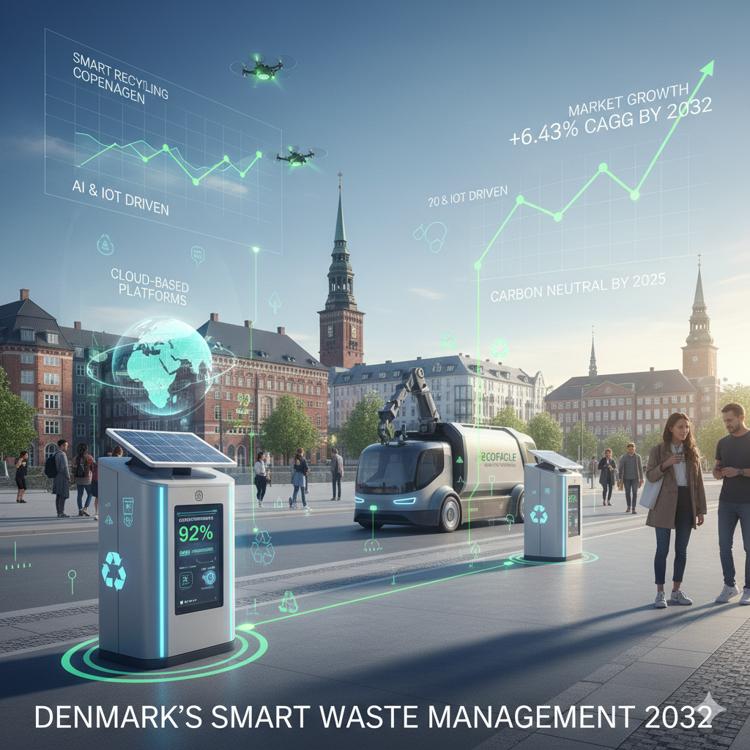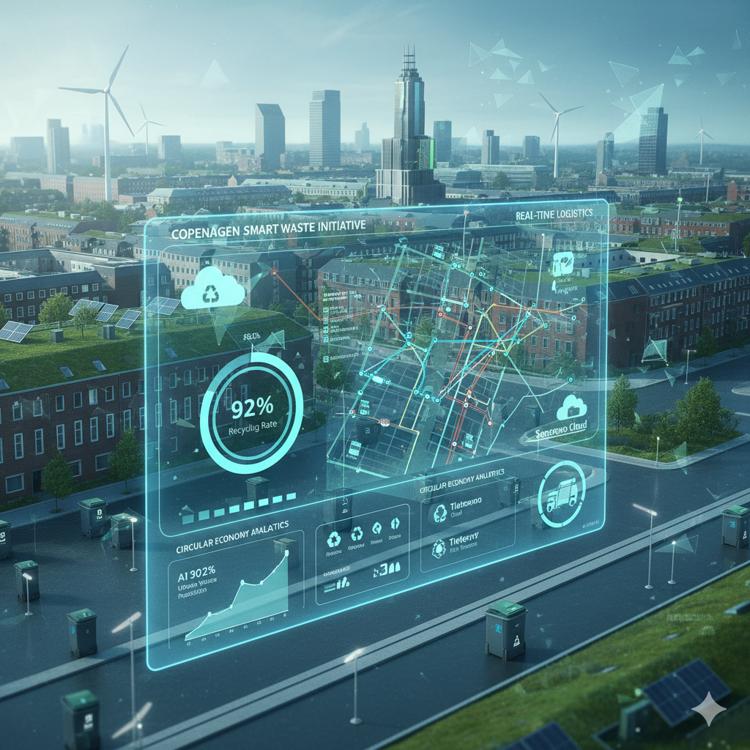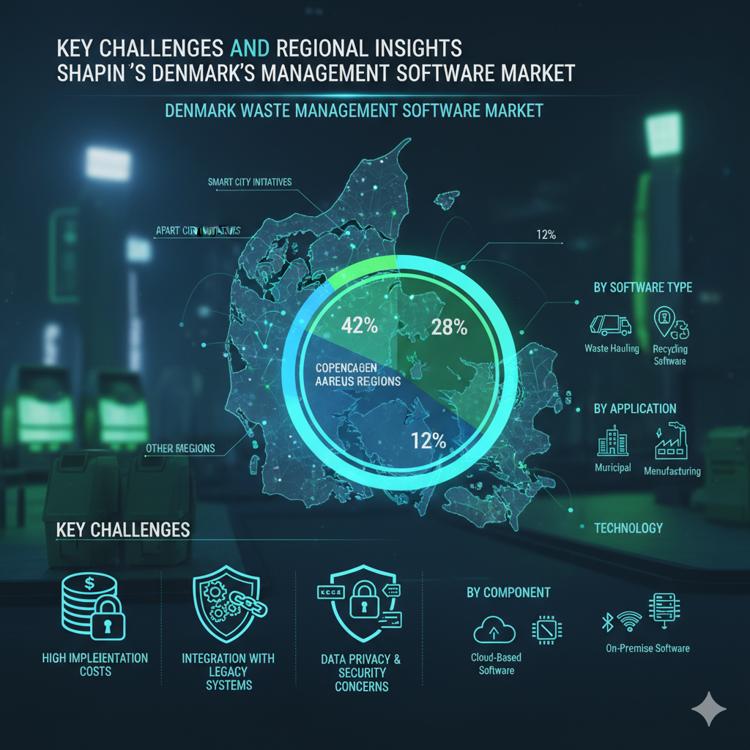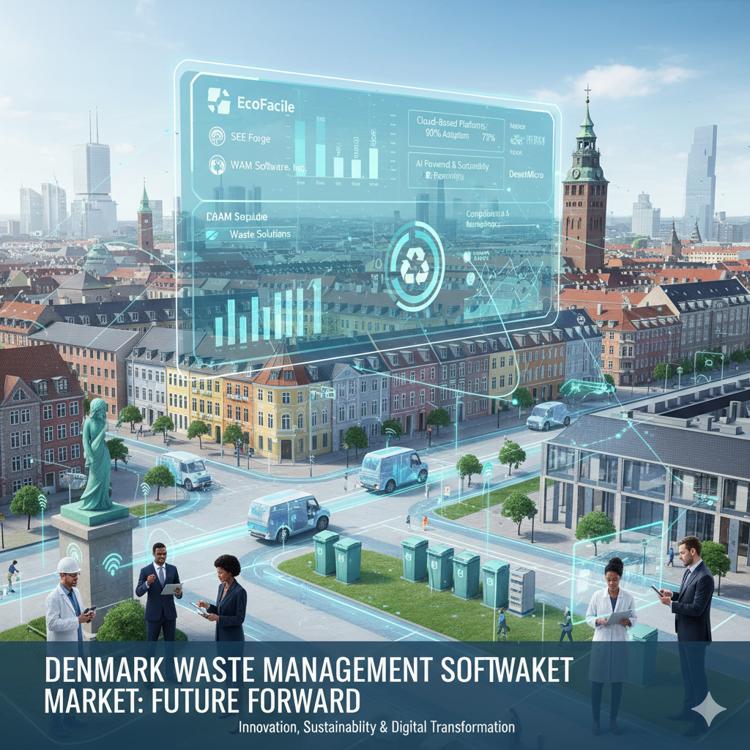-
Feed de Notícias
- EXPLORAR
-
Blogs
How Is Denmark’s Waste Management Software Market Driving Smart City Growth and Sustainability by 2032?

Denmark stands at the forefront of sustainable urban development, with its waste management software market playing a pivotal role in shaping the nation's smart city landscape. Valued at USD 58.87 million in 2024, this market is projected to reach USD 96.90 million by 2032, growing at a CAGR of 6.43% This growth is not merely a reflection of economic trends but a testament to Denmark's commitment to integrating technology with environmental stewardship.
1. What Is Driving the Growth of Denmark’s Waste Management Software Market?
1.1 Technological Advancements
The adoption of cloud-based solutions has been a significant factor, with such platforms commanding a 63% market share in 2024. These solutions offer scalability, cost-efficiency, and real-time analytics, making them ideal for municipalities and enterprises aiming to optimize waste management processes. Additionally, the integration of AI and IoT technologies has enabled features like smart bins and dynamic routing, further enhancing operational efficiency
1.2 Policy and Regulatory Support
Denmark's alignment with EU directives and its national sustainability programs have created a conducive environment for the growth of waste management software. Municipalities are increasingly adopting digital solutions to meet recycling targets and reduce landfill dependency, driven by both regulatory requirements and environmental goals .
2. How Are Smart Cities Benefiting from These Technological Advancements?
2.1 Enhanced Operational Efficiency
Smart waste management solutions, such as those offered by companies like WasteHero, utilize AI-driven analytics to optimize collection routes and schedules. This not only reduces fuel consumption and operational costs but also minimizes the environmental footprint of waste collection activities.
2.2 Improved Recycling Rates
The integration of recycling modules within waste management software has facilitated better tracking and sorting of recyclable materials. This has led to higher recycling rates, supporting Denmark's circular economy initiatives and reducing the strain on.
2.3 Real-Time Monitoring and Data-Driven Decisions
Cloud-based platforms enable real-time monitoring of waste collection processes, providing municipalities with actionable insights. This data-driven approach allows for proactive maintenance, timely interventions, and continuous improvement in waste management strategies
3. What Role Does Copenhagen Play in This Transformation?
Source: Denmark Waste Management Software Market Size, Share & Forecast 2032
Copenhagen, Denmark's capital, exemplifies the successful implementation of smart waste management solutions. The city has invested in intelligent waste bins and dynamic routing systems, significantly reducing waste collection times and enhancing service delivery. These initiatives align with Copenhagen's broader goal of achieving carbon neutrality by 2025, positioning the city as a model for sustainable urban development
4. How Are Key Market Players Contributing to This Growth?
4.1 EcoFacile
EcoFacile offers comprehensive waste management software solutions that integrate route optimization, recycling tracking, and compliance management, catering to both municipal and enterprise needs.
4.2 AMCS Group
AMCS Group provides cloud-based platforms that facilitate efficient waste collection and recycling processes, leveraging data analytics to enhance operational performance.
4.3 SEE Forge
SEE Forge specializes in sensor-based technologies that enable real-time monitoring of waste levels, optimizing collection schedules and reducing operational costs.
4.4 TRUX
TRUX offers a platform that connects municipalities with waste haulers, streamlining communication and improving service delivery through data-driven insights.
4.5 WAM Software
WAM Software provides solutions that integrate with existing municipal systems, enhancing waste tracking, reporting, and compliance management capabilities.
4.6 Sequoia Waste Solutions
Sequoia Waste Solutions focuses on developing scalable software platforms that support municipalities in achieving sustainability goals through efficient waste management practices.
4.7 DesertMicro
DesertMicro offers software solutions that automate waste collection processes, improving efficiency and reducing the environmental impact of waste management activities.
5. What Are the Future Prospects for Denmark’s Waste Management Software Market?
The market's projected growth to USD 96.90 million by 2032 indicates a continued upward trajectory, driven by ongoing technological advancements and policy support. As municipalities and enterprises increasingly prioritize sustainability and operational efficiency, the demand for innovative waste management software solutions is expected to rise, further integrating digital technologies into Denmark's urban infrastructure.
How Rising Waste Volumes and Smart Technologies Are Driving Denmark’s Waste Management Software Market
The Denmark Waste Management Software Market is experiencing steady growth, driven by a combination of rising municipal waste volumes, stringent environmental regulations, and the demand for operational efficiency across sectors. Valued at USD 58.87 million in 2024 and projected to reach USD 96.90 million by 2032, the market is expanding at a CAGR of 6.43%, reflecting Denmark’s ongoing commitment to sustainable urban development and smart city initiatives.
Key Growth Drivers
1. Rising Municipal Waste Volumes
One of the primary drivers of the Denmark Waste Management Software Market is the increasing generation of municipal waste. Urban population growth and higher population density in cities like Copenhagen have led to a significant rise in household and commercial waste. Municipal authorities require advanced digital solutions to manage waste streams efficiently, optimize collection routes, and ensure compliance with environmental policies.
Automated route management and real-time tracking systems are increasingly adopted to reduce operational costs and improve service delivery. Cloud-based platforms provide municipalities with scalable solutions capable of handling growing waste volumes while promoting sustainability.
Case in point: Sensoneo, a global provider of smart waste management solutions, offers cloud-based systems using Microsoft Azure that support real-time bin monitoring and automated route optimization across IoT networks like NB-IoT and LoRaWAN. Such solutions enable cities to manage increasing waste volumes more efficiently.
2. Stringent Environmental Regulations
Denmark’s regulatory framework, aligned with EU directives, has become a major catalyst for waste management software adoption. Stricter rules regarding recycling targets, landfill reduction, and emissions control demand precise data management and automated reporting. Municipalities, businesses, and recyclers are increasingly relying on software to track and document their operations in compliance with legal requirements.
Software solutions not only ensure adherence to regulations but also reduce the risk of penalties for non-compliance. They enable automated documentation, sustainability reporting, and efficient data collection for audits.
Example: In August 2024, the European Recycling Platform Denmark launched automated compliance and reporting services for producer responsibility regulations. These systems help local businesses meet mandatory packaging registration and documentation requirements, highlighting the regulatory push driving software adoption.
3. Demand for Operational Efficiency
Operational efficiency remains a critical factor in the Danish market. Waste management software provides organizations with real-time visibility into fleet operations, recycling outcomes, and asset utilization. Tools for route optimization, equipment maintenance, and scale management reduce operational costs while enhancing productivity.
Cloud-based platforms further enhance efficiency by allowing remote monitoring, analytics-driven decision-making, and improved resource allocation. Industries including manufacturing, healthcare, and retail are increasingly deploying such systems to streamline waste handling processes.
Insight: The growing focus on operational efficiency drives software adoption among municipalities and private enterprises seeking to optimize workflows and minimize waste management costs.
Key Trends and Market Opportunities
1. Expansion of Smart Waste Technologies
Smart city initiatives in Denmark are creating fertile ground for software vendors. The integration of IoT-enabled bins, RFID tags, and sensors allows real-time monitoring of waste levels, improving collection scheduling and reducing unnecessary pickups. Software platforms that incorporate predictive analytics and AI-based automation are increasingly in demand.
Case study: Copenhagen Municipality collaborated with Nordsense to deploy IoT sensors in street-level waste bins, enabling dynamic scheduling of collection based on fill-level data. This initiative exemplifies Denmark’s commitment to data-driven urban infrastructure and sustainable resource management.
2. Growth of Cloud-Based Platforms
The transition to cloud-based waste management solutions is another defining trend in the market. Cloud platforms offer scalability, lower upfront costs, and remote accessibility, making them ideal for municipalities and enterprises alike. Software-as-a-Service (SaaS) models allow for easy integration with existing systems, real-time updates, enhanced security, and multi-site operations management.
Example: In August 2025, Tietoevry Tech Services partnered with COSMO CONSULT to deliver Microsoft Dynamics 365 ERP solutions with cloud capabilities. The collaboration enabled waste management companies to optimize complex material flows and digitalize operations across the Nordic region, demonstrating the potential of cloud-based solutions in transforming the sector.
3. Adoption of AI and Predictive Analytics
Advanced analytics, AI, and machine learning are becoming integral to modern waste management solutions. Predictive modeling helps municipalities anticipate peak waste generation periods, optimize fleet deployment, and allocate resources efficiently. AI-driven route optimization not only reduces operational costs but also contributes to lowering the environmental footprint of waste collection activities.
4. Integration with Circular Economy Initiatives
Denmark’s focus on circular economy principles, including recycling and material recovery, creates additional opportunities for waste management software vendors. Digital platforms that track, sort, and report recyclable materials help municipalities and enterprises meet sustainability targets while improving resource efficiency.

Key Challenges and Regional Insights Shaping Denmark’s Waste Management Software Market
The Denmark Waste Management Software Market is expanding steadily, driven by rising urban waste volumes, smart city initiatives, and cloud-based platforms. However, several challenges and regional dynamics influence adoption across municipalities, enterprises, and industries. Below is a detailed, fact-based overview highlighting market obstacles, regional insights, and segmentation trends.
Key Challenges in the Denmark Waste Management Software Market
1. High Implementation Costs
o Significant upfront investment for licensing, infrastructure, and employee training.
o Smaller municipalities and SMEs often struggle to allocate sufficient budgets.
o Advanced modules such as predictive analytics and real-time tracking are particularly costly.
o Vendors are encouraged to provide scalable, flexible pricing models to drive adoption.
2. Integration with Legacy Systems
o Many organizations rely on outdated IT infrastructure, complicating software deployment.
o Integration can lead to compatibility issues, additional costs, and operational disruptions.
o Resistance from smaller operators slows adoption.
o Emphasis on interoperability and robust integration support is critical for success.
3. Data Privacy and Security Concerns
o Digitization introduces cybersecurity risks via real-time tracking, cloud storage, and IoT integration.
o Data breaches could result in regulatory penalties and reputational damage.
o Denmark’s strict data protection framework requires compliance-focused software solutions.
o Vendors must invest in encryption, access control, and regular audits to build trust.
Regional Analysis
1. Copenhagen (42% Market Share)
o Leading hub due to smart city initiatives and investment in digital waste tracking.
o Strong adoption of cloud-based platforms enhances operational efficiency and reduces emissions.
o Healthcare and retail sectors drive demand for compliance-focused solutions.
o IoT-enabled solutions integrated with waste collection infrastructure are in high demand.
o Circular economy practices accelerate adoption of advanced waste management software.
2. Aarhus (28% Market Share)
o Focused on industrial and manufacturing waste streams.
o Advanced recycling technologies and scale management systems support regional sustainability goals.
o Cloud-based deployment ensures flexibility for municipal and private enterprises.
o Growing demand for route management and waste tracking software from logistics and retail sectors.
o Public-private partnerships provide favorable conditions for software vendors.
3. Odense (18% Market Share)
o Rising adoption among mid-sized enterprises and local municipalities.
o RFID-based tracking systems enhance operational accuracy.
o Key adopters include healthcare and retail sectors due to strict disposal norms.
o Cost-effective, scalable platforms are in demand among smaller organizations.
o Sustainability policies encourage broader adoption of recycling software.
4. Other Regions (12% Market Share)
o Smaller municipalities and rural areas represent slower adoption due to limited budgets.
o Cloud-based solutions reduce barriers, enabling broader uptake.
o Recycling and route optimization software see steady demand for cost efficiency.
o Government sustainability targets encourage digital adoption even in remote regions.
o Infrastructure projects support consistent market growth across these areas.
Market Segmentations
By Software Type
· Waste Hauling Software
· Waste Tracking Software
· Route Management Software
· Scale Software
· Recycling Software
· Maintenance Software
· Others
By Application
· Municipal
· Retail
· Manufacturing
· Healthcare
· Others
By Component
· Cloud-Based Software
· On-Premise Software
By Technology
· Bluetooth
· Real-Time Locating System (RTLS)
· Radio Frequency Identification (RFID)
· Wi-Fi
· Others
By Region
· Copenhagen
· Aarhus
· Odense
· Other Regions

Who’s Leading Denmark’s Waste Management Software Market and How Are They Shaping Its Future?
The Denmark Waste Management Software Market is growing steadily, driven by rising urbanization, regulatory compliance requirements, and smart city initiatives. But what exactly is shaping the competitive landscape, and how are key players positioning themselves to capture market share?
Which Companies Are Driving Competition in Denmark’s Waste Management Software Market?
Denmark’s market is moderately consolidated, combining both global vendors and local players. Key companies competing for market share include:
- EcoFacile – Focuses on tailored solutions for municipalities and SMEs, leveraging smart waste management modules.
- AMCS Group – Offers cloud-based platforms integrated with route optimization and recycling management features.
- SEE Forge – Specializes in IoT-enabled monitoring systems for municipal and private waste operations.
- TRUX – Provides platforms connecting municipalities and haulers with data-driven operational insights.
- WAM Software, Inc. – Focuses on advanced analytics, compliance reporting, and digital tracking modules.
- Sequoia Waste Solutions – Offers scalable software supporting municipal sustainability goals.
- DesertMicro – Delivers automation-focused solutions for improved waste collection efficiency.
These companies compete by expanding product portfolios, enhancing cloud capabilities, and offering IoT-enabled solutions. While local players target tailored services for municipalities and SMEs, international vendors leverage their financial resources and global experience to enhance technology offerings.
How Are Recent Developments Shaping the Market?
Several strategic moves over the past two years highlight the competitive dynamics in Denmark:
- August 2024: Seenons acquired Waste Group Denmark, expanding its platform and strengthening its European footprint.
- June 2025: Waste Group Denmark rebranded to Seenons Denmark, completing integration and aligning services with the Seenons digital platform.
- August 2025: Tietoevry Tech Services partnered with COSMO CONSULT to offer Dynamics 365-enhanced solutions for Nordic waste companies, enabling end-to-end workflows.
- July 2025: Microsoft signed a long-term agreement with Gaia in Denmark to deliver 2.95 million carbon removal credits from a waste-to-energy project.
These examples demonstrate the market’s emphasis on strategic partnerships, acquisitions, and digital integration, which are key to gaining competitive advantage.
What Are the Current Trends Influencing Market Competition?
- Cloud-Based Platforms and Scalability
- Vendors are increasingly offering SaaS solutions to enable municipalities and enterprises to scale operations efficiently.
- Cloud adoption also supports real-time analytics, automated reporting, and integration with IoT devices.
- IoT and RFID Integration
- Smart bins and RFID-enabled tracking systems are being deployed to optimize collection schedules and monitor waste levels.
- Companies incorporating predictive analytics and automation gain a competitive edge.
- Cybersecurity and Data Protection
- Denmark’s strict data privacy regulations require software providers to invest in encryption, access control, and security audits.
- Vendors prioritizing cybersecurity features are better positioned to gain trust among municipalities and enterprises.
- Compliance and Sustainability Reporting
- Software with advanced reporting capabilities supports adherence to Denmark’s circular economy goals and EU directives.
- Healthcare, manufacturing, and retail sectors are driving demand for compliance-focused modules.
- Strategic Partnerships and Market Expansion
- Local and global vendors are engaging in collaborations, mergers, and acquisitions to strengthen market penetration.
- Public-private partnerships are facilitating the deployment of advanced waste management solutions in municipalities.
Which Market Segments Are Expected to Grow in the Future?
- AI-Powered Predictive Analytics: Enhancing route planning and operational efficiency.
- Cloud-Based Platforms: Expanding adoption across municipalities and private enterprises.
- IoT and RFID Systems: Widespread integration to monitor waste in real time.
- Recycling Software: Rising demand aligned with circular economy goals.
- Compliance-Focused Solutions: Increasing adoption in healthcare and manufacturing sectors.
- Route Optimization Tools: Driven by smart city initiatives and sustainability objectives.
Vendors that provide cost-effective, modular software packages and sustainability reporting features are expected to capture additional market share in the coming years.
How Are Companies Positioning Themselves for Future Growth?
- Innovation: Continuous investment in automation, advanced analytics, and compliance features.
- Partnerships: Collaborations with municipalities and private enterprises to expand reach.
- Tailored Solutions: Local players are designing modular systems to serve SMEs and mid-sized municipalities.
- Global Experience: International firms leverage expertise to offer robust, scalable platforms.
- Digital Transformation: Vendors are integrating cloud, IoT, and AI to support data-driven waste management.
These strategies reflect the dynamic nature of Denmark’s waste management software sector, where technology adoption, sustainability, and operational efficiency define market leadership.

Conclusion: The Denmark Waste Management Software Market is projected to experience steady growth, increasing from USD 58.87 million in 2024 to USD 96.90 million by 2032, at a compound annual growth rate (CAGR) of 6.43%. This expansion is driven by factors such as rising municipal waste volumes, stringent environmental regulations, and the demand for operational efficiency. Municipalities and private enterprises are increasingly adopting cloud-based, IoT-enabled solutions to enhance waste collection, recycling, and compliance reporting. Key players in the market are focusing on product innovation, strategic partnerships, and the development of specialized modules to meet the evolving needs of the industry. As Denmark continues to prioritize sustainability and smart city initiatives, the waste management software sector is poised for continued growth, offering opportunities for both local and international vendors.
Source: https://www.credenceresearch.com/report/denmark-waste-management-software-market







